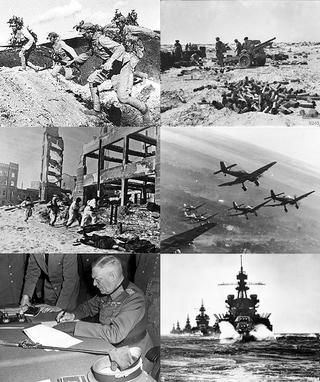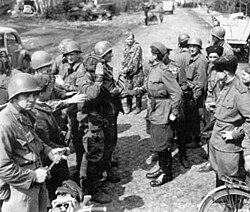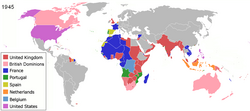World War II
1939–1945 global conflict From Wikipedia, the free encyclopedia
Remove ads
World War II, or the Second World War, was a global conflict involving all continents of the world, except Antarctica. It involved fighting in most of the world from 1939 to 1945. Some fighting started in 1937, when Imperial Japanese forces started the Second Sino-Japanese War. Most of the world's countries, including all of the great powers, fought as part of two military alliances: the Allied Powers and the Axis Powers.
Remove ads
The war involved more countries, cost more money, involved more people, and killed more people than any other war; 73 million people died,[1][2] most of whom were civilians. The war included massacres, a genocide called the Holocaust, strategic bombing, starvation, and disease. This was the only time a nuclear weapon was used in war.
The two sides were the Allies (at first China, France and the United Kingdom, joined by the Soviet Union, United States and others) and the Axis (at first Nazi Germany, Fascist Italy, Vichy France, and Empire of Japan and others).
The war in Asia began when Japan invaded China on July 7, 1937.[3] Combat in Europe began when The Third Reich of Germany invaded Poland on September 1, 1939. France and the United Kingdom reacted by declaring war on Germany. By 1941, most of Europe was under German control, including France, Norway, Austria, Hungary, Denmark, Czechoslovakia, and Poland. Only the British remained fighting against the Axis in North Africa, the Mediterranean, and the Atlantic. Germany gave up plans to invade Britain after losing the air Battle of Britain. In June 1941, Germany invaded the Soviet Union, starting the largest land invasion in history. On December 7, 1941, Japan attacked the United States at Pearl Harbor and invaded British and French colonies in Asia, and two fronts developed: the Western Theatre and the Pacific Theatre.
The Japanese victories were stopped in 1942, and the Soviets won the huge Battle of Stalingrad in early 1943. Then, the Allies started to win in multiple areas. The Axis were forced back from the Soviet Union, weakening in the Scorched Earth tactic. German leaders had not expecting the invasion to last till the hard Russian winter. The Axis also lost North Africa. Starting in 1943, they were forced to defend Italy. Allied forces had a hard time pushing into Italy from Sicily due to its strong defenses.[4] In 1944, the Allies invaded France. The invasion was called D-Day, held in June 6th, 1944. They came into Germany itself from the West, while the Soviets came in from the East. Germany surrendered on May 8 1945, ending the war in Europe.
Japan formally surrendered on September 2 1945, after the Soviets beat the Japanese in Manchuria and the United States dropped two nuclear bombs, "Little Boy" and "Fat Man," had been dropped on Hiroshima and Nagasaki, respectively. This was the only time a nuclear weapon has been used in a real war. As of the present day, the bombings of Hiroshima and Nagasaki have been the only instances in which nuclear weaponry has been used in wartime.[5]
After the war, the United Nations was set up to develop support between countries and to prevent future wars. After World War I, the League of Nations had been built, but it proved ineffective. The Cold War by the major winners soon started, but they did not fight each other in an actual war. The decolonization of Asia and Africa (where many places controlled by European countries were given their independence) happened as well since Europe had been weakened by the war. Economic recovery and political integration (the process of uniting countries) were among other results of the war.
Remove ads
Allies and Axis
The countries that joined the war were on two sides: the Axis and the Allies.
The Axis Powers at the start of the war were Germany, Italy, and Japan. There were many meetings to create an alliance between those countries.[6][7][8][9] Finland (though they never signed the Tripartite pact like other axis members), Slovakia, Romania, Bulgaria, Hungary, Croatia, Vichy France, and Thailand joined the Axis later. As the war continued, some Axis countries like Italy changed sides to join the Allies instead.
The Allied Powers were the United Kingdom and the rest of the British Empire, France, Poland, Yugoslavia, Greece, Belgium, Denmark, Norway, various south and Central American nations after the Japanese attacks on Pearl Harbour, and Finland after September 1944 the Netherlands Belgium and Luxembourg and China, the last of which had been fighting a civil war. In June 1941, Germany attacked the Soviet Union in Operation Barbarossa, which made the Soviets join the Allies. In December 1941 came the Japanese attack on Pearl Harbor against the United States, which then also joined the Allies (The Finns joined the war against the axis in September 1944).
Remove ads
Background
World War I had greatly changed the way of diplomacy and politics in Asia, Europe, and Africa with the defeat of the Central Powers. The empires that had sided with the Central Powers were destroyed. Even the Russian Empire, which was on the Allied side, broke up and became the USSR (Soviet Union) after the Russian Civil War. The war also changed the borders in Eastern Europe, with many new countries being born. Germany was forced to sign the Treaty of Versailles.[10] The Germans also lost 13% of their homeland area and all of their colonies, and they had to pay back a large sum of money to the Allies.[11] The size of their army and navy was also limited,[12] and its air force was banned, except for the 100 airplanes working for the coalmines.
In Italy, nationalists were unhappy with the Versailles Treaty since they thought that their victory as an Ally in WWI should have gained them far more territory from the defeated Austria. The fascist movement in the 1920s brought Mussolini to the leadership of the country. He promised to make Italy a great power by adding to its colonial empire.[13]
After the Kuomintang (KMT), the governing party of China, unified the country in the 1920s, the Chinese Civil War between it and the Communist Party of China began.[14] In 1931, Japan used the Mukden Incident as a excuse to take Manchuria and set up a puppet state, Manchukuo,[15] and the League of Nations failed to do anything to stop it. The Tanggu Truce, a ceasefire, was signed in 1933. In 1936, the Kuomintang and the communists agreed to stop fighting against each other and to fight Japan instead.[16] In 1937, Japan started the Second Sino-Japanese War to take the rest of China.[17]

After the end of the German Empire, the democratic Weimar Republic was set up. There were disagreements among Germans that involved many political ideologies, ranging from nationalism to communism. The fascist movement in Germany rose because of the Great Depression. Adolf Hitler, the leader of the Nazi Party, became the German chancellor in 1933. After the Reichstag fire, Hitler created a totalitarian state in which there was only one party by law.[18] Hitler wanted to change the world order and quickly rebuilt the army, navy, and air force,[19] especially after Saarland voted to return to Germany in 1935. In March 1936, Hitler sent the army to Rhineland. The Spanish Civil War began in July 1936. The war ended in 1939 with the Nationalist victory because of support from Italy and Germany.
In March 1938, Germany sent its army into Austria, known as the Anschluss, which had little reaction from European countries[20] since many Austrians wanted to be part of Germany. Soon, Western Europe agreed to give Sudetenland, the part of Czechoslovakia that was mostly German, to Germany if Hitler promised to stop taking land.[21] However, the rest of the country had been forced to surrender[22] or be invaded by March 1939.[23] The Allies now tried to stop him by promising to help Poland if it was attacked.[24] Just before the war, Germany and the Soviet Union signed a peace agreement that openly stated that they would not attack each other for ten years.[25] Secretly, they also agreed to divide Eastern Europe between them.[26]
Remove ads
Course of the war
War breaks out

World War II began in Europe on September 1, 1939, as Germany invaded Poland. On September 3, Britain and France declared war on Germany. They did not do much to help Poland but sent only a small French attack on Germany from the west.[27] The Soviet Union soon invaded eastern Poland, on September 17.[28] Finally, all of Poland was divided.
Germany then signed an agreement to work together with the Soviet Union. The Soviet Union forced the Baltic countries to allow it to keep Soviet soldiers in their countries.[29] Finland did not accept the Soviet call, and so it was attacked in November 1939.[30] With peace, the world war broke out.[31] France and Britain thought that the Soviet Union might enter the war for Germany and the Soviets were expelled from the League of Nations.[32]
After Poland was defeated, the Phoney War began in Western Europe. British soldiers were sent to the Continent, but no large battles were fought between the two sides.[33] Then, in April 1940, Germany decided to attack Norway and Denmark so that it would be safer to transport iron ore from Sweden. The British and the French sent an army to disrupt the German occupation, but had to leave when Germany invaded France.[34] Neville Chamberlain was replaced by Winston Churchill as British prime minister in May 1940 because of the invasion.[35]
Axis early victories

On 10 May, Germany invaded France, Belgium, the Netherlands, and Luxembourg and quickly defeated them using massive force tactics.[36] The British were forced to leave mainland Europe at Dunkirk. On June 10, Italy invaded France and declared war on it and the United Kingdom. Soon, France was divided into occupation zones. Some were directly controlled by Germany and Italy,[37] and the other was the zone of unoccupied Vichy France.
By June 1940, the Soviet Union moved its soldiers into the Baltic states and took them,[38] followed by Bessarabia in Romania. Although there had been some collaboration between the Soviet Union and Germany earlier, that event made it serious.[39][40] Later, when both countries could not agree to work more closely together, relationships between them became worse to the point of the war.[41]
Germany began an air battle over Britain to prepare for a landing on the island,[42] but the plan was canceled in September when they failed to gain the upper hand. The German Navy destroyed many British ships transporting goods in the Atlantic.[43] Italy had begun its operation in the Mediterranean. The United States remained neutral but started to help the Allies. By helping to protect British ships in the Atlantic, the United States found itself fighting German ships by October 1941 but was not officially at war.[44]
In September 1940, Italy began to invade British-held Egypt. In October, Italy invaded Greece, but that resulted in only an Italian retreat to Italian-occupied Albania.[45] Again, in early 1941, an Italian army was pushed from Egypt to Libya in Africa, but Germany soon helped Italy. Under Erwin Rommel's command, by the end of April 1941, the British were pushed back to Egypt again.[46] Germany also successfully invaded Greece, Yugoslavia and Crete by May.[47] Despite the victories, Hitler decided to cancel the bombing of Britain after 11 May.[48]
Meanwhile, Japan's progress in China was still not much, although the nationalist and communist Chinese began fighting each other again.[49] Japan was planning to take over European colonies in Asia while they were weak, and the Soviet Union could feel a danger from Germany and so a non-aggression pact between the Soviets and the Japanese was signed in April 1941.[50] Germany kept preparing to attack the Soviet Union by moving its soldiers close to the Soviet border.[51]
War becomes global

to September 1, 1941
to September 9, 1941 (operations around Kiev)
to December 5, 1941
On June 22, 1941, the European Axis countries attacked the Soviet Union. This opened a new Eastern Front (World War II). During the summer, the Axis quickly captured Ukraine and the Baltic regions, which caused huge damage to the Soviets. Britain and the Soviet Union formed a military alliance in July.[52] Although there was great progress in the last two months, when winter arrived, the tired German army was forced to delay its attack just outside Moscow.[53] That showed that the Axis had failed its main targets, and the Soviet army was still not weakened. This marked the end of the blitzkrieg stage of the war.[54]
By December, the Soviet Red Army facing the Axis army had received more soldiers from the east since it no longer feared the Japanese. The Soviets began a counterattack and pushed the German army to the west.[55] The Axis lost a lot of soldiers but still had most of the land that it already controlled.[56] By November 1941, the British counterattacked the Axis in North Africa and got all the land back that it had lost.[57] However, the Axis pushed the Allies back again until it was stopped at El Alamein.[58]

In Asia, German successes encouraged Japan to call for oil supplies from the Dutch East Indies.[59] Many Western countries reacted to the occupation of French Indochina by banning oil trading with Japan.[60] Plans to take over European colonies in Asia to create a great defensive area in the Pacific was made by Japan to give it more resources.[61] However, before any future invasion, Japan first had to destroy the American Pacific Fleet in the Pacific Ocean.[62] On December 7, 1941, it attacked Pearl Harbor as well as many harbors in several South East Asian countries.[63] That event led the United States, United Kingdom, Australia, and the Western Allies to declare war on Japan, but the Soviet Union remained neutral.[64] Most of the Axis nations reacted by declaring war on the United States.
By April 1942 the Singapore strategy had failed and many southeast Asian countries (Burma, Malaya, the Dutch East Indies, and Singapore) had almost fallen to the Japanese.[65] In May 1942, the Philippines fell. The Japanese Navy had many quick victories, but in June 1942, Japan was defeated at Midway. Japan could no longer take the land because a large part of its navy was destroyed during the Battle of Midway.
Allies advance
Japan then began its plan to take over Papua New Guinea again,[66] and the United States planned to attack the Solomon Islands. The fight at Guadalcanal began in September 1942 and involved many troops and ships from both sides. It ended with a Japanese defeat in early 1943.[67]
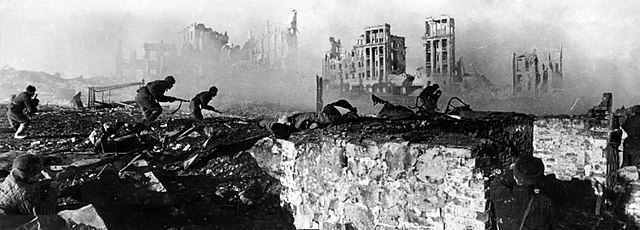
On the Eastern Front, the Axis defeated Soviet attacks during summer and began its own main offensive to southern Russia along Don and Volga Rivers in June 1942 to try to take over oil fields in Caucasus, which were critical to the Axis for fuelling their war effort, and as well as a great steppe. Stalingrad (now Volgograd) was in the path of the Axis army, and the Soviets decided to defend the city. By November, the Germans had nearly taken Stalingrad, but the Soviets surrounded the Germans in the winter[68] After heavy losses, the German army was forced to surrender the city in February 1943.[69] Even though the front was pushed back farther than it was before the summer attacks, the German Army still had become dangerous to an area around Kursk.[70] Hitler devoted almost two-thirds of his armies to The Battle of Stalingrad, which was the largest and deadliest battle at the time.

In August 1942, because of the Allied defense at El Alamein, the Axis army failed to take the town. A new Allied offensive drove the Axis west across Libya a few months later,[71] just after the Anglo-American invasion of French North Africa forced it to join the Allies.[72] That led to Axis defeat during the North African Campaign in May 1943.[73]
In the Soviet Union, on July 4, 1943, Germany started an attack around Kursk. Many German soldiers were lost because of the Soviets' well-created defenses.[74][75] Hitler cancelled the attack before it had any clear outcome.[76] The Soviets then started their counterattack, which was one of the war's turning points. The Soviets, instead of the Germans, then became the attacking force on the Eastern Front.[77][78]
On July 9, 1943, affected by the earlier Soviet victories, the Western Allies landed on Sicily, which resulted in the arrest of Mussolini in the same month.[79] In September 1943, the Allies invaded mainland Italy, following the Italian armistice with the Allies.[80] Germany then took control of Italy, disarmed its army,[81] and built many defensive lines to slow the Allied invasion.[82] German special forces rescued Mussolini and created the German-occupied puppet state of the Italian Social Republic.[83] In late 1943, Japan conquered some islands in India and began an invasion of the mainland of India. The British Indian Army and other forces expelled it in early 1944.

In early 1944, the Soviet army drove off the German army from Leningrad[84] (now Saint Petersburg) and ended the longest and deadliest siege in history. After that, the Soviets began a large counterattack. By May, the Soviets had retaken Crimea. With the attacks in Italy from September 1943, the Allies succeeded in capturing Rome on June 4, 1944, and made the German forces fall back.[85]
War ends in Europe
American and Soviet soldiers meeting east of the Elbe river, Germany (April 25, 1945)
On D-Day, on June 6, 1944, the Allies began the invasion of Normandy, France. The codename for the invasion was Operation Overlord. The successful invasion led to the defeat of the German forces in France. Paris was freed in August 1944, and the Allies continued eastward while the German front collapsed. Operation Market Garden was the combined aerial invasion of the Netherlands and was launched on September 17, 1944. The purpose was to seize a series of bridges that included a bridge in Arnhem, which spanned the Rhine River. The airborne invasion was called Market. The ground invasion, named Garden, reached the Rhine but could not take the bridge.
On June 22, the Soviet offensive on the Eastern Front codenamed Operation Bagration, destroyed almost all of the German Army Group Centre.[86] Soon, the Germans were forced to retreat and to defend Ukraine and Poland. The arriving Soviet troops caused uprisings against the German government in Eastern European countries, but they failed to succeed unless they were helped by the Soviets.[87] Another Soviet offensive forced Romania and Bulgaria to join the Allies.[88] Communist Serbian partisans under Josip Broz Tito retook Belgrade with some help from Bulgaria and the Soviet Union. By early 1945, the Soviets had attacked many German-occupied countries: Greece, Albania, Yugoslavia, and Hungary. The Soviets made Finland switch to the Allies.
On December 16, 1944, the Germans tried one last time to take the Western Front by attacking the Allies in Ardennes, Belgium, in a battle known as the Battle of the Bulge. It was the last major German war attack, and the Germans were unsuccessful in their attack.[89]

By March 1945, the Soviets had moved quickly from Vistula River in Poland to East Prussia and Vienna, and the Western Allies had crossed the Rhine. In Italy, the Allies pushed forward while the Soviets attacked Berlin. The Western Allies eventually met up with the Soviets at the Elbe River on April 25, 1945.
Hitler committed suicide on April 30, 1945, two days after Mussolini had been killed.[90] In his will, Hitler appointed his navy commander, Grand Admiral Karl Donitz, to be his successor.[91] Donitz surrendered to the allies, and opposed Hitler for wanting Germany to continue fighting.
End of war in Europe
German forces in Italy surrendered on April 29, 1945. Germany surrendered to the Western Allies on May 7, 1945, known as V-E Day, and was forced to surrender to the Soviets on May 8, 1945. The final battle in Europe ended in Czechoslovakia, on May 11, 1945.[92]
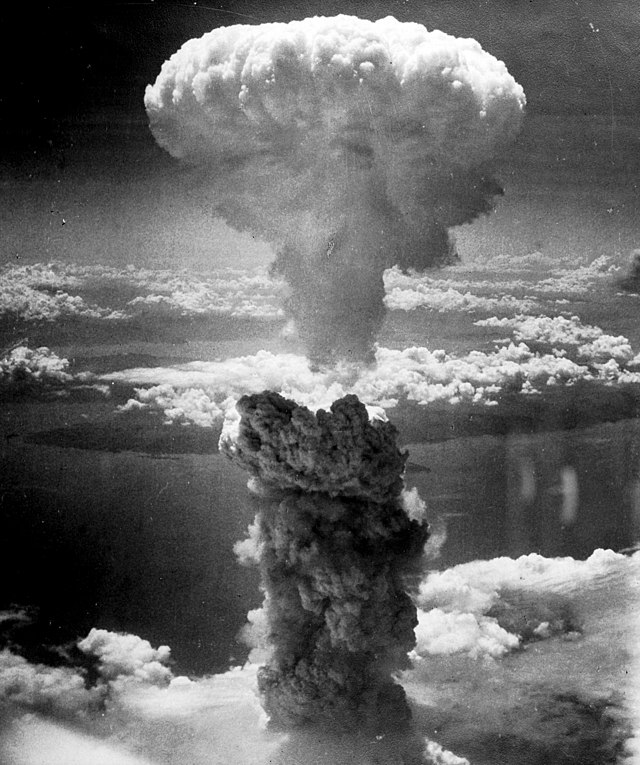
End of war in Asia
In the Pacific, American forces arrived in the Philippines in June 1944. By April 1945, American and Philippine forces had cleared many of the Japanese forces, but fighting continued in some parts of the Philippines until the end of the war.[93] British and Chinese forces had advanced in Northern Burma and captured Rangoon by May 3, 1945.[94] American forces had taken Iwo Jima by March and Okinawa by June 1945.[95] Many Japanese cities were destroyed by Allied bombings, and Japanese imports were cut off by American submarines.
The Allies wanted Japan to surrender without conditions, but Japan refused to do so. The United States dropped two atomic bombs over Hiroshima (August 6, 1945) and Nagasaki (August 9, 1945). On August 8, 1945, the Soviets entered the war against Japan and invaded Manchuria and quickly defeated the primary Imperial Japanese Army there.[96] On August 15, 1945, Japan surrendered to the Allies. The surrender documents were formally signed on board the USS Missouri on September 2, 1945, which ended the war.[97]
Remove ads
Aftermath
The Allies managed to occupy Austria and Germany. Germany was divided into four. The Soviets controlled the east, and the United States, United Kingdom, and France controlled the west. The Allies began denazification, removing Nazi ideas from public life in Germany,[98] and most high-ranking Nazis were captured and brought to a special court. Germany lost a quarter of its land in 1937, mostly to Poland and the Soviet Union. The Soviets also took some parts of Poland[99][100][101] and Finland[102] as well as the three Baltic countries.[103][104]
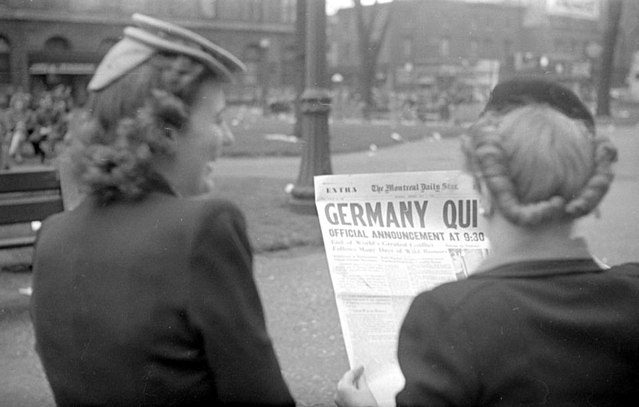
The United Nations was formed on October 24, 1945[105] to keep peace between countries in the world.[106] However, the relationship between the Western Allies and the Soviet Union had worsened during the war[107] and, soon after it, each power quickly built up their power over the controlled area. In Western Europe and West Germany, it was the United States, while in East Germany and Eastern Europe, it was the Soviet Union, which turned many countries into communist states. The Cold War led to the formation of the American-led NATO and the Soviet-led Warsaw Pact.[108]
In Asia, Japan was put under American occupation. In 1948, Korea was divided into North Korea and South Korea, each claiming to be the legal representative of the Koreans, which led to the Korean War in 1950.[109] The civil war in China continued from 1946 and resulted in the KMT retreating to Taiwan in 1949[110] after the communists had won the mainland. In the Middle East, the Arabs' disagreed with the United Nations plan to create Israel, which marked the beginning of conflicts between the Arabs and Israel.
After the war, decolonization took place in many European colonies.[111] Bad economies and people wanting to rule themselves were the main reasons. In most cases, that happened peacefully, except in some countries, such as Indochina and Algeria.[112] In many regions, European withdrawal caused divisions among the people who had different ethnic groups or religions.[113]
Economic recovery was different in many parts of the world, but in general, it was quite positive. The United States became richer than any other country; by 1950, it had taken over the world's economy.[114][115] It also decided on the Marshall Plan (1948–1951) to help European countries. The German,[116] Italian,[117][118] and French economies recovered.[119] However, the British economy was badly harmed[120] and continued to worsen for more than ten years.[121] The Soviet economy grew very fast after the war was over.[122] That also happened with the Japanese economy, which became one of the largest economies in the 1980s.[123] China returned to the same production level as before the war by 1952.[124]
Remove ads
Effects
Death and war crimes
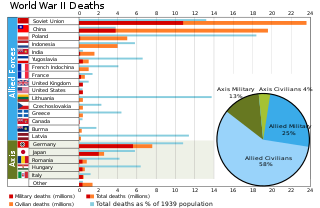
There is no exact number of deaths because many were unrecorded. Many studies said that more than 60 million people died in the war, mostly civilians. The Soviet Union lost around 27 million people,[125] almost half of the recorded number of deaths,[126] which means that 25% of the Soviets were killed or wounded in the war.[127] About 85% of the total deaths were on the Allies, and the other 15% were on the Axis. Mostly, people died because they were sick, hungry to death, bombed, or the wrong ethnicity.
The Nazis selected many groups of people to be killed in what is known as known as The Holocaust. They killed Jews, Roma, Poles, Russians, homosexuals, and other groups.[128] Around 11 million[129] to 17 million[130] civilians died. Around 7.5 million people were killed in China by the Japanese.[131] The most well-known Japanese crime is the Nanking massacre, in which hundreds of thousands of Chinese civilians were raped and murdered. There were reports that the Germans and Japanese tested biological weapons against civilians[132] and against prisoners-of-war.[133]
Although many Axis war crimes were brought to the first international court,[134] no Allied war crimes were.
Concentration camps and slave work

Other than the Holocaust, about 12 million people, mostly Eastern Europeans, were forced to work for the German economy.[135] German concentration camps and Soviet gulags caused many deaths. Both sides treated prisoners of war badly. That was the case even for Soviet soldiers who survived and returned home.
Japanese prisoner-of-war camps, many of which were used as labor camps, also caused many deaths. The death rate of Western prisoners was 27.1%,[136] seven times that of prisoners under Germans and Italians.[137] More than 10 million Chinese civilians were made slaves and had to work in mines and war factories.[138] Between 4 and 10 million people were forced to work in Java.[139]
Between 1942 and 1945, US President Franklin Roosevelt signed an order that made Japanese Americans go to internment camps since he feared them helping an invasion. Some Germans and Italians were included as well.
The Allies agreed that the Soviet Union could use prisoners of war and civilians for forced labor.[140] Hungarians were forced to work for the Soviet Union until 1955.[141]
Home fronts and production
Before the war in Europe, the Allies had a larger population and economy than the Axis. If colonies were included, the GDP of the Allies would be twice that of the Axis.[142] In Asia, however, China had a GDP only 38% higher than Japan if colonies were counted.[142]
The Allied economy and population compared with the Axis lessened with the early Axis victories. However, that was no longer the case after the United States and the Soviet Union joined the Allies in 1941. The Allies had a higher production level than the Axis because of more natural resources. Also, Germany and Japan did not plan for a long war and even had no ability to do so.[143][144] Both tried to improve their economies by using slave laborers.[145]
Women
As men went off to fight, women took over many of the jobs that they left behind. At factories, women were employed to make bombs, guns, aircraft, and other equipment. In Britain, thousands of women were sent to work on farms as part of the Land Army. Others formed the Women's Royal Naval Service to help with building and repairing ships. Even Princess Elizabeth, who later became Queen Elizabeth II, worked as a mechanic to aid the war effort. By 1945, some weapons were being made almost entirely by women.
In the beginning, women were rarely used in the labor forces in Germany and Japan.[146][147] However, Allied bombings[148][149] and the German change to a war economy made women take a greater part.[150]
In Britain, women also worked in gathering intelligence at Bletchley Park and other places. The mass evacuation of children also had a major impact on the lives of mothers during the war years.
Occupation
Germany had two different ideas of how it would occupy countries. In Western, Northern, and Central Europe, Germany set economic policies that would make it rich. During the war, the policies brought as much as 40% of total German income.[151] In the east, the war against the Soviet Union meant Germany could not use the land to gain resources. The Nazis used their racial policy and murdered a lot of people they thought were non-human. The Resistance, the group of people secretly fighting Germany, could not harm Germany much until 1943.[152][153]
Japan claimed to free colonized Asian countries from European colonial powers in Asia. Although it was welcomed at first in many territories, its cruel actions soon turned people against it.[154] During the occupation, Japan used 4 million barrels of oil that had been left behind by the Allies. By 1943, Japan produced up to 50 million barrels of oil in the Dutch East Indies, was 76% of its 1940 rate.[154]
Developments in technology

The war brought new methods for future wars. The air forces improved greatly in fields such as air transport,[155] strategic bombing to use bombs to destroy industry and morale,[156] radar, and weapons for destroying aircraft. Jet aircraft were developed and were used worldwide in air forces.[157]
At sea, the war focused on using aircraft carriers and submarines. Aircraft carriers soon replaced battleships,[158][159][160] mainly for being cheaper.[161] Submarines, a deadly weapon since World War I,[162] also played an important part in the war. The British improved weapons for destroying submarines, such as sonar, while the Germans improved submarine tactics.[163]
The style of war on the land had changed from World War I to be more mobile. Tanks, which had been used to support infantry, changed to being primary weapons.[164] The tank was improved in speed and firepower during the war. At the start of the war, most commanders thought that using better tanks was the best way to fight enemy tanks.[165] However, early tanks could harm armour only a little. The German idea to avoid letting tanks fight each other meant tanks facing tanks rarely happened. That was a successful tactic in Poland and France.[164] Ways to destroy tanks also improved. Vehicles became more used in the war, infantry remained the main part of the army.
Submachine guns became widely used, especially in cities and jungles.[166] The assault rifle, a German development combining features of the rifle and submachine gun, became the main weapon for most armies after the war.[167]
Other developments included better encryption for secret messages, such as the German Enigma. Another feature of military intelligence was the use of deception, especially by the Allies. Others include the first programmable computers, modern missiles and rockets, and the atomic bombs.
Remove ads
Losses
Military losses
Most authorities now agree that of the 30 million Soviets who fought, there were 13.6 million military deaths.
*Total of which 7,800,000 were battlefield deaths
**Including Australia, Canada, India, New Zealand, etc.
Civilian losses
Deaths among civilians during this war, many of which resulted from famine and internal purges, such as in China and the Soviet Union, were colossal but less well documented than those by the fighting forces. Although the figures are the best available from authoritative sources and present a broad picture of the scale of civilian losses, the precise numbers will never be known.
Axis Powers

Germany, Italy, Japan, Hungary, Romania, Bulgaria, Thailand, Croatia
Allied Powers
United States, British Empire, France, Soviet Union, Australia, Belgium, Brazil, Canada, China, Denmark, Greece, Netherlands, New Zealand, Norway, Poland, South Africa, Yugoslavia
There is no exact number of deaths because many were unrecorded. Many studies said that more than 60 million people died in the war, mostly civilians. The Soviet Union lost around 27 million people, almost half of the recorded number of deaths, which means that 25% of the Soviets were killed or wounded in the war. About 85% of the total deaths were on the Allies, and the other 15% were on the Axis. Mostly, people died because they were sick, hungry to death, bombed, or the wrong ethnicity.
The Nazis selected many groups of people to be killed in what is known as known as The Holocaust. They killed Jews, Roma, Poles, Russians, homosexuals, and other groups. Around 11 million to 17 million civilians died. Around 7.5 million people were killed in China by the Japanese. The most well-known Japanese crime is the Nanking massacre, in which hundreds of thousands of Chinese civilians were raped and murdered. There were reports that the Germans and Japanese tested biological weapons against civilians and against prisoners-of-war.
Although many Axis war crimes were brought to the first international court, no Allied war crimes were.
Remove ads
Related pages
| Media from Commons | |
| News stories from Wikinews | |
| Quotations from Wikiquote | |
| Source texts from Wikisource | |
| Textbooks from Wikibooks | |
| Learning resources from Wikiversity | |
Notes
References
Other websites
Wikiwand - on
Seamless Wikipedia browsing. On steroids.
Remove ads
